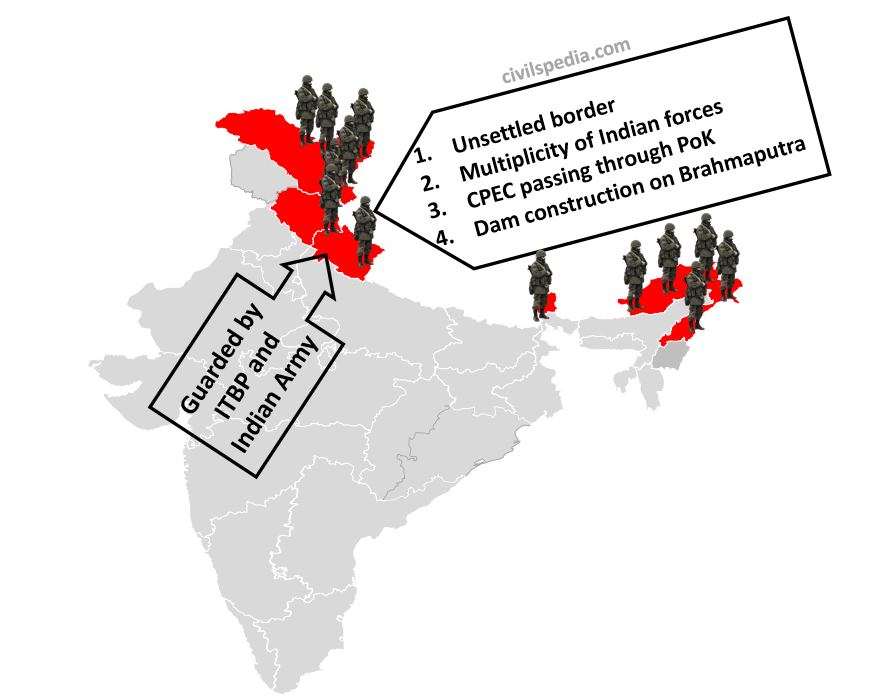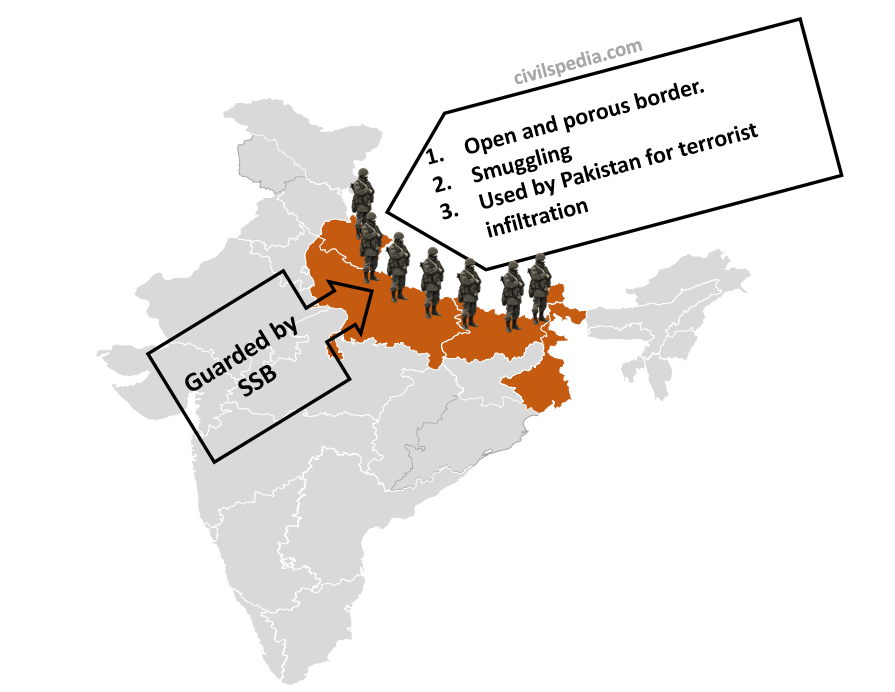Issue of Drug Trafficking
This article deals with the ‘Issue of Drug Trafficking .’ This is part of our series on ‘Internal Security’, which is an important pillar of the GS-3 syllabus. For more articles, you can click here.
Introduction
- Drug Trafficking is an important topic. Hence, we will do this topic in detail.
- As per Home Ministry, there are 40 lakh drug addicts in India.

How is India used as Transit for Drug Trafficking?

1. India-Pakistan Border
- Golden Crescent, the largest producer of opium & cannabis in the world, is situated on the feet of the Indo-Pakistan Border.
- Porous borders, disturbance in the areas, closing traditional Balkan route via Iran during the Iran-Iraq war (1980-1988), the outbreak of the Sikh militancy in the mid-1980s and the Kashmir militancy in the late 1980s, support from Pakistan etc., are the major reasons behind drug trafficking across India-Pakistan border.
2. India-Nepal & India-Bhutan Border
- Two-way smuggling is happening in this region as
- Heroin and Marijuana / Ganja come to India from Nepal and Bhutan.
- Low-cost Codeine-based pharma preparation from India is exported to Nepal & Bhutan.
- Well-developed road infrastructure and porous borders facilitate this business.
3. India-Myanmar Border
- India – Myanmar border is situated on the foot of the Golden Triangle.
- The growing demand for drugs in the North-East and insurgency and porous nature of the Indo-Myanmar border facilitate this.
4. Sea Routes
- Both the east & west coasts of India are used for the drug trade.
- During the 1990s, the civil war started in Sri Lanka. Hence drugs from the Af-Pak region came to India & exited through Sri Lanka.
- Tuticorin & Kochi emerged as the top drug trafficking ports in India.
5. Air Routes
- Both major & minor airports are used in this pursuit. These include Delhi, Mumbai, Amritsar, Hyderabad and Bangalore airports.
- Drugs are trafficked from these airports to Lagos & Addis Ababa for African drug cartels.
6. Domestic Production
- Additionally, India produces a considerable quantity of opium, part of which finds a place in the illicit market.
- E.g., In Rajasthan, farmers can produce opium for medicinal purposes after getting a license. But a considerable part of opium thus produced is smuggled into the illegal market.
Side Note: Golden Crescent and Golden Triangle
- The golden crescent refers to the mountainous area of Iran, Afghanistan and Pakistan.
- Golden triangle is the region of Myanmar, Laos, Vietnam and Thailand, south of the Chinese border.
Opium has been grown in these regions for hundreds of years, and they are the two major sources of narcotic drugs worldwide.
Why is India vulnerable to drugs?
- India is situated in the vicinity of Golden Triangle and Golden Crescent, and it acts as a transit point for drugs from Golden Triangle and Crescent. Furthermore, cannabis (ganja) also grows in many parts of the country and marijuana is cultivated in hilly regions of India (like Mallana in Himachal Pradesh).
- Indian Parliament has passed the Narcotics Drugs and Psychotropic Substance (NDPS) Act of 1985, providing minimum punishment of 10 years. But its implementation by the states has been tardy.
- India’s border with Nepal, Bangladesh and Myanmar is porous. Along with that, there are issues with border guarding infrastructure. The drug traffickers exploit these loopholes for the illegal trade of drugs into India.
- Drug Trafficking is also used to fund terrorist activities by insurgents in the North East.
- Some religious sects also promote the drug, as many Hindu deities are associated with drugs such as marijuana.
- Unemployment among the youth takes them on the path of drug abuse.
- The rise of virtual currencies like Bitcoin has also increased funding avenues for smugglers and drug traffickers.
- The breakage of the joint family system and traditional societal milieu and the emergence of an individualistic lifestyle have been other reasons for people falling into the drug trap.
- Role of media: Glorification of drug abuse in media, such as in web series and movies.
Impact of Drug Abuse
- Impact on Individual: Drug Abusers suffers from diseases, such as HIV, and the development of mental illnesses, suicides etc.
- Impact on the Family: Families of drug abusers suffer from domestic violence, which adversely affects the mental and physical well-being of women and children.
- Socio-Political Impact: It threatens social stability as the crime rate increases rapidly. Drug abusers indulge in robbery and other crimes to buy drugs.
- Threat to the demographic dividend of India: It takes a significant toll on valuable human lives and causes loss of productive years of person.
- Threat to National Security: Various terrorist groups are involved in the business of drug trafficking to fund their activities.
Steps taken by the government
- Parliament has already passed Narcotics Drugs and Psychotropic Substances Act, 1985 (NDPS Act), with a minimum punishment of 10 years. The central government can add or omit any drug from the list of psychotropic substances. For instance, in 2015, the central government classified mephedrone – also called meth or meow meow – as a psychotropic substance in the Act after its popularity grew among the youth.
- Narcotics Control Bureau (NCB) has been constituted under the Narcotics Drugs and Psychotropic Substances Act, 1985 (NDPS Act) to control the menace of the drug in the country.
- India has strengthened its border security infrastructure and Coast Guard to stop the entry of drugs from neighbouring countries.
- India has signed and ratified International Conventions, namely.
- UN Convention on Narcotic Drugs
- UN Convention on Psychotropic Substances
- India has entered into arrangements like bilateral Agreements and Memorandum of Understanding with Nepal, Thailand and Myanmar on Drug Trafficking.
- According to Article 47 of the Indian Constitution, the state is duty-bound to prevent the consumption of intoxicating drinks and drugs.
Way forward
- Cutting off the drug supply lines by law enforcement agencies should be the priority.
- Government should strictly enforce the provisions of the Narcotic Drugs and Psychotropic Substances Act.
- Government and society should focus on creating mass awareness programs using the educational system, media, and religious figures.
- Sports facilities and other facilities which keep youth engaged in constructive work, like NCC, NSS, and youth parliaments, should be promoted.
- Many drugs in India have religious sanctions because they are associated with Hindu deities, so religious organizations must be roped in.
- The number of rehab centres and healthcare professionals for addicts is very few. These facilities should be increased.
- Big corporate houses should provide counselling facilities for their employees as employment-related stress is emerging as a major factor leading to drug addiction.



















































